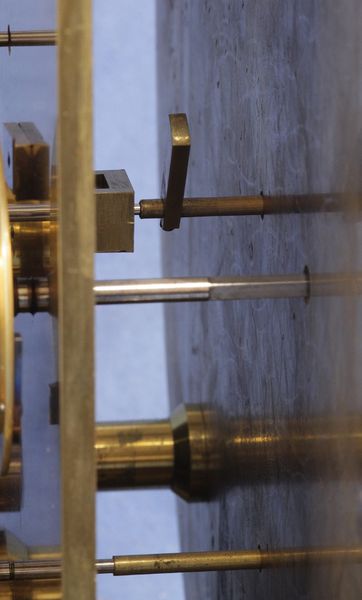Datei:William Hardy, London 1825 PPU (09).jpg

Originaldatei (512 × 848 Pixel, Dateigröße: 182 KB, MIME-Typ: image/jpeg)
A Very Important English Observatory Regulator Clock, circa 1825.
Maker: William Hardy, London
Case: The superb quality figured mahogany floor standing case has an arched hood with raised ebony strips, a hinged hood door with a turned brass bezel and flat glass, a glazed waist door flanked by stop-chamfers and a plinth with a simple base and applied ebony moldings.
Dial: The heavy silvered engraved circular dial has observatory marks on the seconds chapter, a twenty-four hour chapter ring, blued steel hands and is signed, ‘Willm. Hardy, Invt. Et Fecit, London’, in the center.
Movement: The massive lacquered movement has thick arched plates, five heavy screwed pillars, delicate six spoke wheels with high tooth counts, screwed collets, a counterweight for the minute hand, screwed end-caps, a brass weight with integral pulley, a barrel with 19 turns, a mahogany dust cover and thick brass seatboard. The spring-detent escapement is planted on the backplate, has a delicate finely cut five spoke escape wheel that rides in jeweled chatons front and back. The compensating pendulum has several screwed adjustments including a sliding micro adjustment, a mercury filled glass jar with lid, a silvered engraved scale mounted to an ebonized block across the backboard, an adjustable brass t-block that engages the escapement and is suspended by a steel suspension from a thick rectangular bracket mounted across the tops of the plates.
Notes: William Hardy moved from Scotland in 1800 and eventually settled at 28 Coppice Row, Coldbath Fields. He was a creative and skilled maker who applied his skills to both the theoretical and practical sides of horology in an effort to overcome the intrinsic inefficiencies common in mechanical clockwork. Having had success with watches and chronometers, he turned his attention to the regulator developing a new spring pallet escapement in 1807. He also developed several horological tools and was the first practical horologist in England to make epicycloidal cutters for wheels and pinions. The cut surface was said to be ‘like glass’ and prompted Charles Frodsham to write in 1862 “the train and wheelwork in Hardy’s regulators is among the best in England, and the shape of the wheels and pinions makes the most perfect gearing I have ever witnessed”. Hardy delivered his first clock, ordered by Nevil Maskelyne, in April, 1811 to The Old Royal Observatory in Greenwich where it stood in the Circle Room until Nov. 1823 when it replaced Graham’s regulator as the Transit Clock. The clock performed well at Greenwich and public and private orders from all over the world quickly followed. It is thought that 28 regulators were made with 18 being recorded. As far as we know, this is an unrecorded example. Hardy’s movements were made by Thomas Leyland, a skilled workman, who also provided movements to several eminent makers including Vulliamy, Frodsham and Condliff. Not withstanding the glazed door, this example seems to bear a significant aesthetic resemblance to the Cambridge Clock at The Maddingly Road Observatory. It has similar chamfered pillars, the hood lock oriented out the side and nearly identical grain patterns on the plinth. This would seem to indicate the mahogany came from the same specimen and the case must have been made at the same time and by the same person. The heavy brass seatboard is signed in ink on the underside. It seems to read ‘W Baily’, but other interpretations are possible. The Dr. Pearson clock is also signed in ink on the mahogany movement cover which helped determine the original owner.
This clock was purchased at auction in 1991. The escapement detents and pallets had been badly repaired, but it had never been converted or ‘Dented’. In 1993 Roger Stevenson did the restoration of the spring pallets as well as making a new weight, pendulum jar and lid, the rear chaton and some screws. All the original broken pieces were kept.
For more on William Hardy and his clocks see:
‘English Precision Clocks’, Derek Roberts, Chapter 6.
‘Antiquarian Horology’, Charles Allix, Summer 1990, pg. 607.
‘Antiquarian Horology’, A.J. Turner, Winter 1979, Pg. 615.
Christies, London, Sale 7012, Lot 14.
Sotheby’s, New York, Sale NO7816, Lot 174.
Size: 72.5 inches.
Sundial Farm Antique Clocks Ltd.
Lizenz
Dateiversionen
Klicke auf einen Zeitpunkt, um diese Version zu laden.
| Version vom | Vorschaubild | Maße | Benutzer | Kommentar | |
|---|---|---|---|---|---|
| aktuell | 13:59, 14. Nov. 2016 |  | 512 × 848 (182 KB) | Andriessen (Diskussion | Beiträge) | A Very Important English Observatory Regulator Clock, circa 1825. <br> Maker: William Hardy, London<br> Case: The superb quality figured mahogany floor standing case has an arched hood with raised ebony strips, a hinged hood door with a turned brass be… |
Du kannst diese Datei nicht überschreiben.
Dateiverwendung
Keine Seiten verwenden diese Datei.
